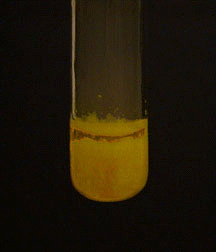Characteristic Reactions of Cadmium Ions (Cd²⁺)
- Page ID
- 97265
- Most common oxidation state: +2
- M.P. 321º
- B.P. 767º
- Density 8.65 g/cm3
- Characteristics: Cadmium is a silvery, crystalline metal, resembling zinc. Moderately active. \(\ce{Cd^{2+}}\) is colorless in solution and forms complex ions readily.
Characteristic reactions of Cd²⁺
Aqueous Ammonia
Aqueous ammonia reacts with cadmium ion to precipitate white cadmium hydroxide, which dissolves in excess ammonia:
\[\ce{Cd^{2+}(aq) + 2NH3(aq) + 2H2O(l) <=> Cd(OH)2(s) + 2NH4^{+}(aq)} \nonumber \]

\[\ce{Cd(OH)2(s) + 4NH3(aq) <=> [Cd(NH3)4]^{2+}(aq) + 2OH^{-}(aq)} \nonumber \]

Addition of 6 M \(\ce{NaOH}\) to a solution of \(\ce{Cd(NH3)4^{2+}}\) precipitates a white basic salt of unknown formula. This salt is not soluble in ammonia.
Sodium Hydroxide
Sodium hydroxide produces a precipitate of \(\ce{Cd(OH)2}\), but the precipitate does not dissolve in excess hydroxide:
\[\ce{Cd^{2+}(aq) + 2OH^{-}(aq) <=> Cd(OH)2(s)} \nonumber \]

Hydrogen Sulfide
Hydrogen sulfide reacts with cadmium ion to precipitate yellow-orange cadmium sulfide from basic, neutral, or weakly acidic solutions:
\[\ce{Cd^{2+}(aq) + H2S(aq) <=> CdS(s) + 2H^{+}(aq)} \nonumber \]
\[\ce{Cd^{2+}(aq) + HS^{-}(aq) <=> CdS(s) + H^{+}(aq)} \nonumber \]
\[\ce{Cd^{2+}(aq) + S2^{-}(aq) <=> CdS(s)} \nonumber \]

Cadmium sulfide is soluble in hot dilute nitric acid:
\[\ce{3CdS(s) + 8H^{+}(aq) + 2NO3^{-}(aq) <=> 3Cd^{2+}(aq) + 2NO(g) + 4H2O(l) + 3S(s)} \nonumber \]

Cadmium sulfide is also soluble in 3 M HCl and in hot, dilute \(\ce{H2SO4}\).
No Reaction
\(\ce{Cl^{-}}\), \(\ce{SO4^{2-}}\)


